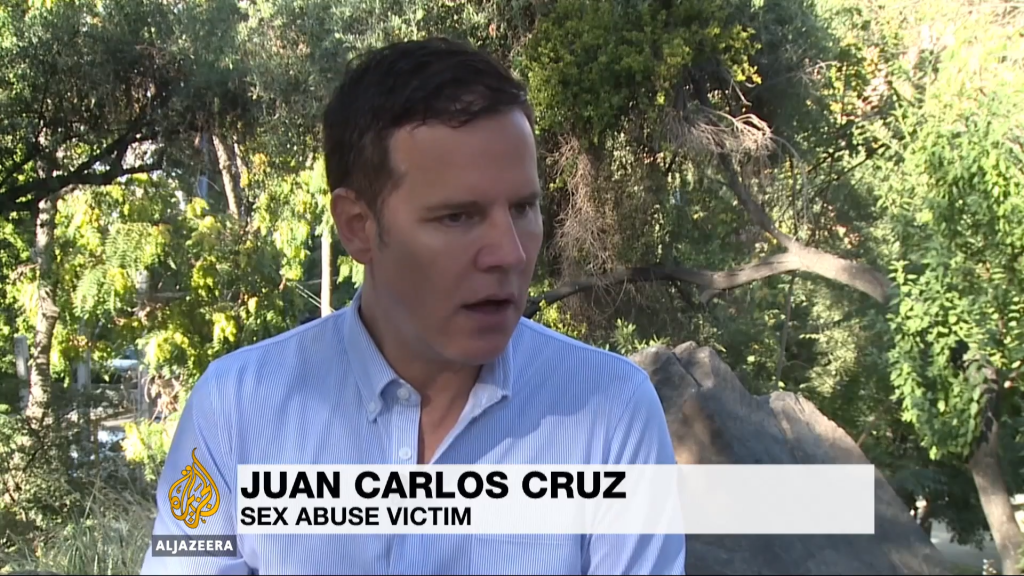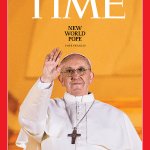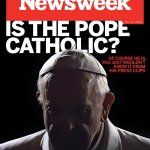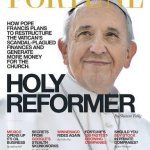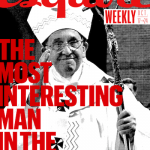Pope Francis Prompts Outrage With Accusations Against Clerical Sex Abuse Victims

Image: Yahoo Video (Screengrab)
In stunning new comments made during his visit to South America this week, Pope Francis has attacked the credibility of victims of notorious clerical sexual abuser Fr. Fernando Karadima. The pope accused abuse victims of “calumny” for their allegations that Bishop Juan Barros, a Karadima protege, knew about the abuse, or even that he watched as it took place. “There is not one shred of proof against him.” Francis said to a Chilean journalist at the end of his visit to Chile. “It’s all calumny. Is that clear?”
On Twitter, Barros’ “most vocal accuser”, Juan Carlos Cruz, lashed out about the absurdity of the pope expecting proof from his abuse:
“As if one could have taken a selfie or a photo while Karadima abused me and others and Juan Barros standing next to him watching everything. These people from above are crazy and @Pontifex is talking about reparation to the victims. We remain the same and his forgiveness remains empty.”
Juan Carlos Cruz, A victim of Fr. Karadima who says Bishop Barros stood by and watched as he was abused. (Aljazeera Video/Screengrab)
Barros reiterated his outrage in an exchange with Crux‘ Austen Ivereigh, when the latter questioned his claims. “Does he need a photo, a selfie, as proof? Sorry Austen, we did not think of it as we were being abused and Juan Barros watching.”
According to the Associated Press, the pope’s “astonishing” comments “drew shock from Chileans and immediate rebuke from victims and their advocates.”
A group of Karadima victims spoke out against the pope’s words yesterday, saying, “This is serious and we cannot accept it … what he has done today is offensive and painful, and it also reveals an unknown face of the Pontiff.”
Talking Tough on Sex Abuse
Those who are surprised by the pope’s comments in Chile are likely more familiar with his tough talk on clerical sex abuse. In September 2015, Pope Francis addressed victims of abuse at St. Charles Borromeo Seminary in Philadelphia in clear, unequivocal terms:
I carry in my heart the stories, the suffering and the pain of the minors who were sexually abused by priests. I’m overwhelmed by the shame that people who were in charge of caring for those young ones raped them and caused them great damages. I regret this profoundly. God weeps! The crimes and sins of sexual abuse to minors can’t be kept a secret anymore. I commit to the zealous oversight of the Church to protect minors, and I promise that everyone responsible will be held accountable.
In June of the following year, the pope issued a new motu proprio letter taking steps further than just words. Entitled “Come una madre amorevole” (As a Loving Mother), the letter established norms seeking the removal of bishops who have, “through negligence, committed or omitted acts that have caused grave harm to others, either with regard to physical persons, or with regard to the community itself.” At the time, Vatican spokesman Fr. Federico Lombardi said that the letter “clarifies that negligence regarding cases of sexual abuse committed against children or vulnerable adults are among the ‘grave causes’ that justify removal from ecclesiastical Offices, even of Bishops.”
During his current visit to South America, Gerard O’Connell of America magazine tweeted about a moment where the pope expressed solidarity with victims:
Vatican spokesman, Greg Burke, said Pope Francis “listened, prayed and cried” with a small group of victims abused by priests, when he met them at the nunciature in Santiago, after lunch today. He spent around half an hour with them, alone, without anyone else present.
Nevertheless, by the end of the trip, the pope expressed his indignance at accusations against Barros from known victims of Fr. Karadima.
Empty Words: The Way Francis Really Deals With Abusers
Despite powerful words and moving gestures, the pope’s track record on dealing with perpetrators of abuse or those who covered for them has been wildly inconsistent. While there have been some cases — like that of the conservative Bishop Robert Finn of the diocese of Kansas City-St. Joseph, who was removed on the basis of what some have termed “politically motivated” charges of neglect — other, more egregious examples have not only gone ignored, but in some cases have been actively thwarted or even promoted by Francis. As we reported in October, 2015, not long after his statement in Philadelphia, the pope’s words and actions on the matter are often worlds apart.
Bishop Barros
The case of Bishop Barros and the controversy that surrounds it is nothing new, though his harsh response in Chile is now bringing attention to an issue that many have never heard about before this week. The appointment of Barros by Francis in 2015 was, in fact, so controversial, that five members of the pope’s anti-abuse commission expressed “concern and incredulity” at the assignment. Similarly, Barros’ installation Mass was forced to be cut short when hundreds of protesters showed up.
It was at this time that Francis first showed his contempt for victims in Chile — a contempt his recent words appear to confirm. In a video from May of 2015, Francis accused those who implicated Barros of being “dumb”:
“The Osorno community is suffering because it’s dumb,” Pope Francis told a group of tourists on St. Peter’s Square in Vatican City, because it “has let its head be filled with what politicians say, judging a bishop without any proof.”
“Don’t be led by the nose by the leftists who orchestrated all of this,” the pope said.
Cardinal Danneels
Also of particular note is the pope’s closeness with Cardinal Godfried Danneels from Belgium, who has become perhaps the most notorious member of the so-called “St. Gallen Mafia” — a group of curial conspirators who worked together to ensure Bergoglio’s election to the papacy. Danneels was caught on tape in 2010 trying to stop a sex abuse victim from going public. As Marcantonio Colonna later reported in The Dictator Pope, Danneels’ home and his diocesan offices were later raided by police, who seized computers and documentation on abuse allegations. “For reasons that remain unclear,” wrote Colonna “the seized evidence was declared to have been inadmissible, the documents returned to the archdiocese and the investigation was abruptly closed. This despite the fact that individuals had come forward with almost five hundred separate complaints, including many that alleged Danneels had used his power and connections to shield clerical sex abusers.” [emphasis added]
Nevertheless, Colonna writes that according to Danneels, the 2013 conclave was for him “a personal resurrection experience.” And sure enough, if one looks closely at the photos of the new pope on the Loggia, standing there in shadows is the triumphant-looking kingmaker himself, the once-disgraced Cardinal Archbishop of Mechelen-Brussels:
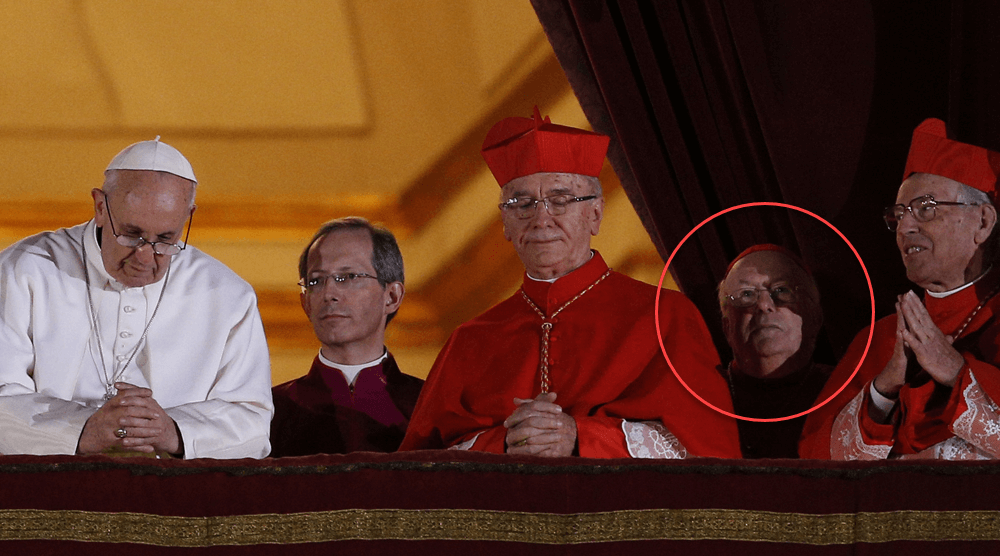 Later, Danneels — a man who was implicated and even recorded in the act of covering up the clerical abuse of children — would be personally invited by the pope to both synods on the family.
Later, Danneels — a man who was implicated and even recorded in the act of covering up the clerical abuse of children — would be personally invited by the pope to both synods on the family.
Father Inzoli
In a January, 2017 report, Michael Brendan Dougherty wrote of a “child abuse scandal” “coming for Pope Francis”. Dougherty detailed the way clerics accused of abuse were able to avoid discipline under Francis by means of powerful friends and connections:
Consider the case of Fr. Mauro Inzoli. Inzoli lived in a flamboyant fashion and had such a taste for flashy cars that he earned the nickname “Don Mercedes.” He was also accused of molesting children. He allegedly abused minors in the confessional. He even went so far as to teach children that sexual contact with him was legitimated by scripture and their faith. When his case reached CDF, he was found guilty. And in 2012, under the papacy of Pope Benedict, Inzoli was defrocked.
But Don Mercedes was “with cardinal friends,” we have learned. Cardinal Coccopalmerio and Monsignor Pio Vito Pinto, now dean of the Roman Rota, both intervened on behalf of Inzoli, and Pope Francis returned him to the priestly state in 2014, inviting him to a “a life of humility and prayer.” These strictures seem not to have troubled Inzoli too much. In January 2015, Don Mercedes participated in a conference on the family in Lombardy.
This summer, civil authorities finished their own trial of Inzoli, convicting him of eight offenses. Another 15 lay beyond the statute of limitations. The Italian press hammered the Vatican, specifically the CDF, for not sharing the information they had found in their canonical trial with civil authorities. Of course, the pope himself could have allowed the CDF to share this information with civil authorities if he so desired.
Francis was subsequently forced to laicize Inzoli last summer. But not until the predator priest had shown up at a family conference where he had no business being. For his part, it was Cardinal Coccopalmerio who had petitioned Francis to give an apartment in the CDF building to his secretary, Msgr. Luigi Capozzi — an apartment reports later indicated were raided by Vatican police, where last year they allegedly broke up “a drug-fueled, homosexual debauched party.” (Coccopalmerio had also reportedly requested that Capozzi be raised to the episcopacy.)
A Seemingly Impervious Papacy Begins to Crack
For years, Francis’ progressive-friendly papacy has made him nearly bulletproof with the secular press and the progressive Catholic media. His infamous “Who am I to judge?” comment about a known homosexual priest in his employ helped to land him on the cover of “LGBT news” magazine The Advocate as “Person of the Year” in 2013. He has also graced the covers of Rolling Stone, Time, Newsweek, Esquire, Fortune, People, and Vanity Fair, among others — almost always in a positive context. It’s a distinction virtually unknown to his recent predecessors, who more often than not found themselves maligned for their teachings.
But the victim-shaming by the pope this week may mark a change in his fortunes. A few months ago, a Google search of “Pope Francis” and “Sex Abuse” was likely to return our October, 2015 report on Danneels and Barros on the first page of results. But in the wake of the pope’s inconceivably tone-deaf comments in Chile, our report has been buried in a deluge of new stories from major outlets around the world. Rumors of the pope’s temper are a thing of legend, but always from behind closed doors, clouded in anonymous sources. His indignation over the Barros accusations is a rare misstep from arguably the most media-savvy pope in history. Nevertheless, the clerical sex abuse crisis is a powerful third rail in the Church’s relations with the secular world. The damage done here likely won’t soon be forgotten.
Beginning of the End, Or Blip on the Radar?
I’ve said from the outset of 2018 that I think this is the year Francis’ fortunes will turn. The world has reached “peak Francis,” and those who love him, love him for his push towards a new, progressive iteration of Catholicism. The faithful, on the other hand, have had more than their fill of his appetite for destruction. What is certain is that his outrageous comments about abuse victims will not endear him to either camp, lowering his stock among supporters and cementing his reputation among critics.
Still, Francis has enormous good will in the bank among those with a vested interest in the furtherance of his agenda. The news of a papal award being given to one of the most notorious abortion promoters in the world began making international headlines just days after the joint reports first appeared here and at The Lepanto Institute. For the global Left, this was nothing but a feather in the pope’s cap, but the story was quickly drowned out with coos of wistful approval from women the world over (including true believers) when news broke that Francis had offered, on the spot, to officiate the wedding of two flight attendants on a recent papal flight. The couple, so the story went, was planning to marry in 2010 when their parish was damaged by an earthquake. Although they have been living together in a civil marriage for years and have two children, they never found the time to be married in a Catholic Church. The “impromptu” wedding was quickly picked up as yet another heartwarming story demonstrating the humanity of “the people’s pope” — nevermind that it broke a bunch of canon laws, made a triviality of something sacred, set a terrible precedent that will put priests the world over in a tough situation, and was, contrary to a calculated pretense of spontaneity, actually planned out a month in advance. In other words, it was a cheap and transparent PR stunt, but it appears to have done some good for the pope’s damaged image.
When all the smiley face emojis and animated hearts fade, however, the question will remain: how many tricks does a papacy that sees clerical abuse victims unafraid to stand up for themselves as “dumb” people full of “calumny” need to stay afloat? For that matter, how many tricks does it have left?
The Internet is famous for having a short attention span, but there are some things people have a hard time forgetting. Abusing spiritual power to take advantage of children and vulnerable young adults is one of them. With the armor of this papacy finally cracking, it appears there may finally be a chance for the world to see what some of us have long known: the ugly reality that lies beneath.
The post Pope Francis Prompts Outrage With Accusations Against Clerical Sex Abuse Victims appeared first on OnePeterFive.

